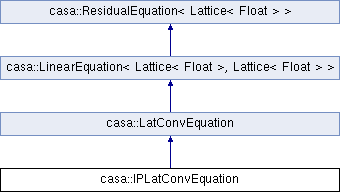|
casa
$Rev:20696$
|
|
casa
$Rev:20696$
|
Implements the image plane lattice convolution equation. More...
#include <IPLatConvEquation.h>

Public Member Functions | |
| IPLatConvEquation (Lattice< Float > &psf, Lattice< Float > &dirtyImage) | |
| Construct the LatConvEquation setting the psf and measured data. | |
| virtual | ~IPLatConvEquation () |
| Somewhere I read that a destructor should alway be defined even if it does nothing (as this one does). | |
| virtual Bool | residual (Lattice< Float > &result, const LinearModel< Lattice< Float > > &model) |
| Calculate the convolution of the model (supplied by the LinearModel class) and the psf and the difference between this and the supplied (presumably measured) convolution. | |
| virtual Bool | residual (Lattice< Float > &result, Float &chisq, const LinearModel< Lattice< Float > > &model) |
| Calculate the convolution of the model (supplied by the LinearModel class) and the psf and the difference between this and the supplied (presumably measured) convolution. | |
Private Member Functions | |
| IPLatConvEquation () | |
| Don't use this one, due to the Lattice<Float> &. | |
Private Attributes | |
| Float | itsQ |
| Factor by which we normalize the PSF for the second convolution. | |
Implements the image plane lattice convolution equation.
Internal
<h3>Review Status</h3><dl><dt>Date Reviewed:<dd>yyyy/mm/dd</dl>
This class implements image plane (ie, single dish) convolution equation within the LinearEquation framework, using Lattices.
This class is used in conjunction with classes like HogbomCleanModel to implement deconvolution algorithms. This class contains the point spread function (psf) and the convolved data (dirty image), and is able to convolve a supplied model with the psf to produce a predicted output (using the evaluate() function), or to subtract the convolved data and produce a residual (using the residual() function).
See the documentation for HogbomCleanModel for an example of how this class can be used to perform deconvolution.
This class also contains specialised functions (like the version of evaluate() for a point source model) that speed up the calculation of the convolution. This specialised version of evaluate() does not need to actually perform the convolution and instead returns a suitable part of the psf (zero padded if necessary). When this function is called this class will get the psf from the convolver and cache it, on the assumption that many evaluations of this function will be requested (as occurs in Clean algorithms).
The size and shape of the psf and the supplied model may be different. The only restriction is that the dimension of the psf must be less than or equal to the dimension of the model. If the dimension of the model is larger than the dimension of the psf then the convolution will be repeated along the slowest moving (last) axis. The dirty image and the supplied model must be the same size and shape.
PagedArray<Float> psf(2,4,4), dirty(2,20,20), model(2,20,20);
.... put some meaningful values into these Lattices...\.
// create a convolution equation, and a PagedArray model
LatConvEquation convEqn(psf, dirty);
LinearModel< Lattice<Float> > myModel(model);
// now calculate the convolution of the model and the psf
PagedArray<Float> prediction;
convEqn.evaluate(myModel, prediction);
// and calculate the difference between the predicted and actual convolution
PagedArray<Float> residual;
convEqn.residual(mymodel, residual)
This class was designed with deconvolution in mind.
Definition at line 120 of file IPLatConvEquation.h.
| casa::IPLatConvEquation::IPLatConvEquation | ( | Lattice< Float > & | psf, |
| Lattice< Float > & | dirtyImage | ||
| ) |
Construct the LatConvEquation setting the psf and measured data.
| virtual casa::IPLatConvEquation::~IPLatConvEquation | ( | ) | [virtual] |
Somewhere I read that a destructor should alway be defined even if it does nothing (as this one does).
| casa::IPLatConvEquation::IPLatConvEquation | ( | ) | [private] |
Don't use this one, due to the Lattice<Float> &.
| virtual Bool casa::IPLatConvEquation::residual | ( | Lattice< Float > & | result, |
| const LinearModel< Lattice< Float > > & | model | ||
| ) | [virtual] |
Calculate the convolution of the model (supplied by the LinearModel class) and the psf and the difference between this and the supplied (presumably measured) convolution.
Reimplemented from casa::LatConvEquation.
| virtual Bool casa::IPLatConvEquation::residual | ( | Lattice< Float > & | result, |
| Float & | chisq, | ||
| const LinearModel< Lattice< Float > > & | model | ||
| ) | [virtual] |
Calculate the convolution of the model (supplied by the LinearModel class) and the psf and the difference between this and the supplied (presumably measured) convolution.
Also return chisq.
Reimplemented from casa::LatConvEquation.
Float casa::IPLatConvEquation::itsQ [private] |
Factor by which we normalize the PSF for the second convolution.
Definition at line 151 of file IPLatConvEquation.h.
 1.8.0
1.8.0